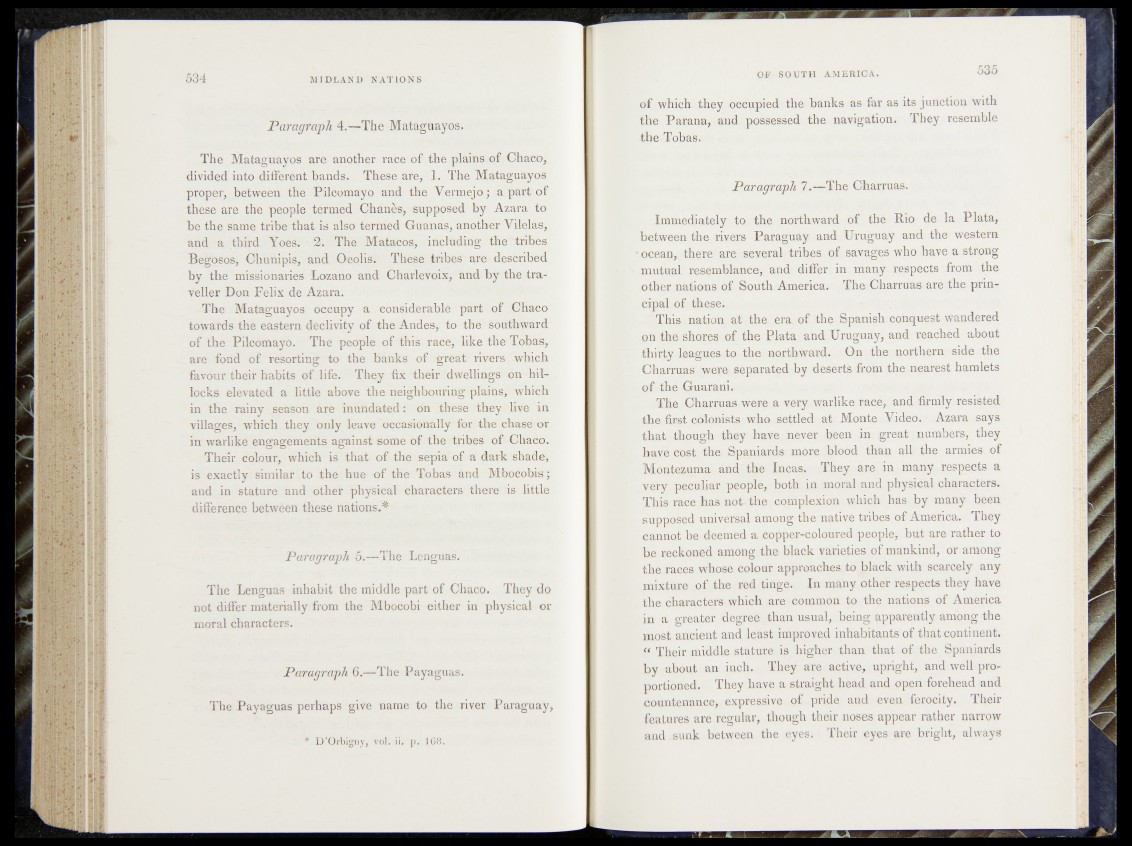
Paragraph 4.—The Mataguayos.
The Mataguayos are another race-of the plains of Chaco,
divided into different bands. These are, pË The Mataguayos
proper, between the Pilcomayö and the. Verm ejo:f a part of
these are the people termed Chanès, supposed by Azara to
be the same tribe that is also termed Guanas, another Vilelas,
and a third Yoes. 2. The Matacos, including the tribes
Begosos, Chunipis, and Oeolis. These tribes are described
by the missionaries Lozano and Charlevoix, and by the traveller
Don Felix de Azara.
The Mataguayos occupy a considerable part o f. Chaco
towards the eastern declivity of the Andes, to the southward
of the Pilcomayo. The people of this race, like the Tobas,
are fond of resorting to the banks of great rivers which
favour their habits of life. They fix their dwellings on hillocks
elevated a little above the neighbouring plains, which
in the rainy season are inundated: on these they live in
villages, which they only leave occasionally for the chase or
in warlike engagements against some of the tribes of Chaco.
Their colour, which is that of the sepia of a dark shade,
is exactly- similar to the hue of the Tobas and Mbocobis;
and in stature and other physical characters there is little
difference between these nations.*
Paragraph 5,—The Lenguas.
The Lenguas inhabit the middle part of Chaco. They do
not differ materially from the Mbocobi either in physical or
moral characters.
Paragraph 6.—-The Payaguas.
The Payaguas perhaps give name to the river Paraguay,
D’Orbigny, vol. ii. p. 168.
of which they occupied the banks as far as its junction with
the Parana, and possessed the navigation. They resemble
the Tobas.
Paragraph 7.—The Charruas.
Immediately to, the northward of the Rio de la Plata,
between the rivers Paraguay and Uruguay and the western
pgean, there are several tribes of savages who have a strong
mutual resemblance, and differ in many respects from the
other .nations of South America. The^ifiarrUas are the principal,
of the&e.
This nation at the era of the Spanish conquest wandered
pn the shores of the Plata and Uruguay, and reached about
thirty leagues to the northward. < On the northern side the
Charruas'were separated by deserts from the -nearest hamlets
of the Guarani.
The Charruas were a very warlike race, and firmly resisted
the first colonists who settled at Monte Video. Azara says
that though they have never been in great numbers, they
have cost the, Spaniards more blood than all the armies of
Montezuma and the Incas. They are in many respects a
very peculiar people, both in moral and physical characters.
This race has not- the complexion which has by many been
supposed universal among the native tribes of America. They
cannot be deemed a copper-coloured people, but are rather to
be reckoned among the black varieties of mankind, or among
the races whose colour approaches to black with scarcely any
mixture of the red tinge. In many other respects they have
the characters which are common to the nations of America
in a greater degree than usual, being apparently among the
most ancient and least improved inhabitants of that continent.
“ Their middle stature is higher than that of the Spaniards
by about an inch. They are active, upright, and well proportioned.
They have a straight head and open forehead and
countenance, expressive of pride and even ferocity. Their
features are regular, though their noses appear rather narrow
and sunk between the eyes. > Their eyes are bright, always